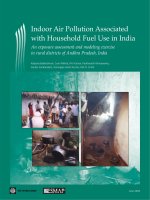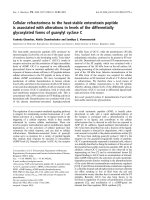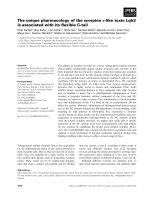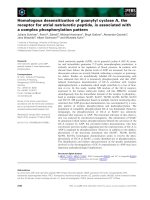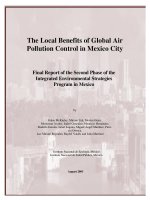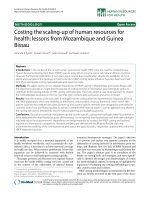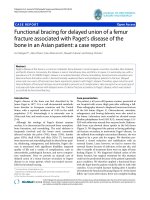The build up of pore air pressure associated with water in filtration into geomaterials under heavy rainfall condition
Bạn đang xem bản rút gọn của tài liệu. Xem và tải ngay bản đầy đủ của tài liệu tại đây (2.73 MB, 57 trang )
Master of Engineering dissertation
TRAN TUAN ANH
(16ME136)
Graduate School of Science and Engineering
Saitama University, Japan
February, 2018
THE BUILD-UP OF PORE-AIR PRESSURE ASSOCIATED
WITH WATER INFILTRATION INTO GEOMATERIALS
UNDER HEAVY RAINFALL CONDITION
A dissertation submitted to the Graduate School of Science and
Engineering in partial fulfillment of the requirement of the degree of
Master of Engineering
by
TRAN TUAN ANH
16ME136
Supervised by
Professor Dr. Masahiko Osada
Rock Mechanics Laboratory
Graduate School of Science and Engineering
Department of Civil Engineering
Saitama University
Japan
1
ABSTRACT
Water infiltration into unsaturated soils is an important geotechnical problem related to
large deformation and failure of natural slopes and soil structures. The failure of soils can be
triggered by a wetting process from an unsaturated stage resulting from an increase in moisture
content and a decrease in suction. It is suggested that the pressure parameters play a significant
role in investigation water infiltration phenomena. Pore-air generally does not impede
infiltration rates or wetting front movement when the water table is at depth. However, poreair entrapment is not often considered as a function of water infiltration process but affects.
Therefore, the study of water infiltration into unsaturated soils becomes an interesting topic
due to the necessity of understanding the complex nonlinear interaction among the hydrological
conditions, the hydraulic and pressure parameters of the unsaturated soils related to water
infiltration.
The objective of this study is to investigate the variation of pressure parameters
associated with the water infiltration into geomaterials as a function to develop a complete
influence rating procedure of heavy rainfall triggering landslide in further studies.
To this end, a series of numerical simulation method associated with laboratory
experiments based on the theory of multiphase-flow in porous media were carried out. The
laboratory experiments were conducted that there were two different column of sandy soil cases
developed to evaluate the influence of pore-air entrapment on infiltration under different initial
conditions. The bottom of the soil column is bounded to make the air entrapment condition.
Neither the air nor the water can pass through the vertical column walls. In the simulation
method, a model was designed which fit with the laboratory experiments to investigate the
behavior of pore air pressure during water infiltration in general. Besides, a column of sandy
soil was conducted that assumes water rising from the base as the effect of water table with soil
in open system. The soil surface approaches the atmosphere and there is no air escape from the
base. The incoming water from the base force the water elevation toward the surface of the soil
column as the effect of capillary pressure.
The results showed that under closed conditions the wetting front migrates significantly
slower following a rapid absorption at the early stage. During closed infiltration, the only
avenue for the movement of air phase is upwards through the advancing wetting zone to the
soil surface and leak out as bubbles, which allows water absorbing to available pores space
2
until the wetting front reaching the bottom of the soil column.
The pore pressure behavior corresponds with the velocity of the movement of wetting
front. In the closed system, pore air pressure jumps up as fast as water infiltrating when it
contacts to the soil surface. During the interval, pore air pressure that is under the wetting front
is similar at any points within the soil system. Pore air pressure at a specific position within
soil will decrease only when it contacts to the wetting front whilst the remaining keep rising.
At the moment, pore air pressure is approximately capillary pressure. So that, the pore air
pressure increases proportionally to the depth. Pore air pressure also slows down the infiltration
rate by the reduction of capillary pressure, the time lag between the pore air pressure at
considered points indicates the velocity of advance of the wetting front. Besides, the soil will
not be fully saturated until pore air pressure is equal to zero.
In open system, the air phase contacts to the atmosphere, and pore air pressure is
approximatess zero in entire time. The pore air pressure can still affect to the migration of
wetting fluid, but negligible. So that, the effect of pore air pressure can be ignored in the open
system.
Keywords:
Pore-air pressure, heavy rainfall, numerical simulation, infiltration
3
ACKNOWLEDGEMENTS
It is my great pleasure to submit this thesis to the Graduate School of Science and
Engineering, Department of Civil Engineering, Saitama University for the partial fulfilment of
the degree in Master of Engineering. This dissertation would not have being a real fulfillment
without the backing and corporation from various individuals through various means. It is a
pleasure to convey my gratitude to all of them.
In the first place I owe my everlasting gratefulness to my supervisor, Professor, Dr.
Masahiko Osada for his keen supervision. I take this opportunity to convey my heartiest
gratitude to Professor. Dr. Masahiko Osada, my academic supervisor for the guidance and
supervision rendered during my research to make it successful. His truly scientist perception
has made him as a constant oasis of ideas and passions in science, which exceptionally inspire
and enrich my growth as a student, a researcher and a scientist. Your patient guidance and
valuable comments and making me well experienced on academic writing and resource
handling.
It is my pleasure to convey my noble thanks to Associate Professor Dr. Tadashi
Yamabe, Professor, Dr. Kawamoto Ken for valuable advices. Special gratitude goes for
Associate Professor, Dr. Chiaki T. Oguchi who gave us great occasions to travel many locations
in Japan. Thanks for your guidance and their willingness to share experience with us. It is my
pleasure to convey my thanks to Senior Professor Jiro Kuwano for giving us opportunity to
join geotechnical field visits and enjoyable ski tour. These field visits helped to learn new
approaches in geotechnical field and also, we could explore many places around Japan.
I appreciate the help that I got from Rock mechanics lab members as well as the friends
of Geosphere Research Institute. It is a pleasure to pay a special tribute to KESCO, Ltd.
company especially Mr. Kuo Ozawa, Mr. Yuto Takahashi, and Mr. Dahai Mi who guide me in
various aspects of numerical simulation with COMSOL Multiphysics in my research work.
Further it is my duty to remember Mr. Kenjiro Okada who being my tutor and a kind person in
all my academic and nonacademic work. Special thanks go to Tsuchiya san, Hosokawa san and
Araya san for the continuous support during my laboratory experiments and friendship that
share with me all the time.
4
My special thanks go to Asian Development Bank to offer me a valuable scholarship
to study in a world first class country like Japan without any financial difficulties. I am very
grateful to the international students, staff members of GRIS including Nara san, Foreign
Student Office with Yuko Mori san and Sachiko Shimodaira san, Saitama University
International House, International affairs office and graduate school staff and Japanese
language teacher, Jonishi sensei for guide me the life in Japan.
I would like to dedicate this dissertation to my loving family who show me the clear
path of my life and being with me all the time. Your courage, support and love helped me a lot
to achieve all my targets throughout the life.
5
TABLE OF CONTENT
ABSTRACT .............................................................................................................................. 1
ACKNOWLEDGEMENTS .................................................................................................... 4
TABLE OF CONTENT........................................................................................................... 6
LIST OF FIGURES ................................................................................................................. 8
LIST OF TABLES ................................................................................................................. 11
CHAPTER 1 ........................................................................................................................... 12
INTRODUCTION.................................................................................................................. 12
1.1
GENERAL INTRODUCTION .............................................................................. 12
1.2
HEAVY RAINFALL AND WATER INFILTRATION ...................................... 13
1.3.
AIR ENTRAPMENT FORMATION BY WATER INFILTRATION .............. 15
1.4
RESEARCH OBJECTIVES .................................................................................. 16
1.5
LIMITATIONS OF THE STUDY ......................................................................... 17
1.6
THESIS OUTLINE ................................................................................................. 17
CHAPTER 2 ........................................................................................................................... 19
LITERATURE REVIEW ..................................................................................................... 19
2.1
GENERAL ............................................................................................................... 19
2.1.1
Previous studies on water infiltration behavior ................................................. 19
2.1.2
Effect of pore pressure distribution to water movement within soil .................. 21
2.2
MOTIVATION OF THIS STUDY ........................................................................ 25
CHAPTER 3 ........................................................................................................................... 26
LABORATORY EXPERIMENTS OF WATER INFILTRATION ................................. 26
3.1
GENERAL ............................................................................................................... 26
6
3.2
MATERIAL PROPERTIES .................................................................................. 27
3.3
EXPERIMENTAL PREPARATION AND PROCEDURE ................................ 28
3.4
RESULT AND DISCUSSION ................................................................................ 31
CHAPTER 4 ........................................................................................................................... 35
NUMERICAL SIMULATION OF 1-DIMENSIONAL INFILTRATION PROBLEMS
IN GEOMATERIAL ............................................................................................................. 35
4.1
GENERAL INTRODUCTION .............................................................................. 35
4.2
GOVERNING EQUATION .................................................................................. 36
4.3
RESULTS AND DISCUSSION.............................................................................. 39
4.3.1. Water infiltration in a closed system ...................................................................... 39
4.3.2. Capillary rise in open system.................................................................................. 46
CHAPTER 5 ........................................................................................................................... 53
CONCLUSIONS .................................................................................................................... 53
5.1
GENERAL ............................................................................................................... 53
5.2
FUTURE RECCOMANDATIONS ....................................................................... 54
REFERENCES ....................................................................................................................... 55
7
LIST OF FIGURES
Fig 1.1: Relation of rainfall to surface runoff, Ewing and Washington block, St. Louis, Sept.
7, 1916...................................................................................................................................... 14
Fig 1.2: Schematic cross section of a slope under a heavy rainfall condition ......................... 15
Figure 2.1 Conceptualization of water content profiles during infiltration, redistribution, and
drainage (deep percolation) (Ravi et al. 1998)......................................................................... 20
Figure 2.2: Air pressure with time: from top to bottom, capillary tube with different internal
diameter (Culligan et al. 2000) ................................................................................................ 22
Figure 2.2 Capillary pressure-water saturation relationship for various air and water flow
regimes (Adam. S, 2013) ......................................................................................................... 24
Fig 2.3: Typical capillary functions for sand and clay............................................................. 24
Fig 3.1: Schematic of the experiment of water infiltration in a closed system
a. Initial state, b. After infiltration ........................................................................................... 26
Figure 3.2: Water-retention characteristic curve for Toyoura sand ......................................... 27
Fig 3.3: Sensor measurement equipment (Source: ........................ 28
Figure 3.4: Schematic diagram of water infiltration experiment
and pore air pressure measurement .......................................................................................... 29
Figure 3.5: Sensors arrangement (4 sensors) ........................................................................... 30
Figure 3.6: Sensors arrangement (2 sensors) ........................................................................... 31
Figure 3.6: Pore air pressure variation at different points
during water infiltration process at the build-up stage (with 4 sensors)
Figure 3.7: Pore air pressure variation at different points
during water infiltration process at the buil-up stage (with 2 sensors) .................................... 32
Figure 3.8: Escape air from the soil system ............................................................................. 33
Figure 3.9: Experiment with 2 sensors after water fully infiltrated ......................................... 34
Figure 4.1: Schematic diagram of water infiltration in closed system
8
a. Initial state, b. After infiltration ........................................................................................... 40
Figure 4.2: Geometry of the model and boundary condition ................................................... 41
Figure 4.3: Considered points and Meshing
a – Considered points, b – Meshing ......................................................................................... 41
Fig 4.4: Water saturation profiles at time t=0 min(a), and t = 5 min (b) ................................. 42
Figure 4.5: Pore air and pore water pressure contribution at different positions
of soil column .......................................................................................................................... 42
Figure 4.6: Pore air pressure profiles at different positions of soil column
from times t=0 min to t=60 min ............................................................................................... 43
Figure 4.7: Pore air pressure profiles at different positions of soil column
in buil-up stage ......................................................................................................................... 43
Figure 4.8: Pore water pressure profiles at different positions of soil column
from times t=0 min to t=60 min ............................................................................................... 44
Figure 4.9: Capillary pressure profiles at different positions of soil column
in entire process (a), and build-up stage (b) ............................................................................. 45
Figure 4.10: Pore air pressure profiles at different positions of soil column
a. 7 cm hydraulic head, b. 10cm hydraulic head ...................................................................... 46
Figure 4.11: Schematics of capillary raise model in opened system ....................................... 48
Figure 4.12: Geometry of the model and boundary condition
a – wetting phase; b – nonwetting phase; blue line: no flow ................................................... 48
Figure 4.13: Considered points and Meshing
a – Considered points, b – Meshing ......................................................................................... 49
Figure 4.14: Water saturation profiles from time t=0 min(a), and t = 60 min (b) ................... 49
Figure 4.15: Pore air and pore water pressure contribution
at different positions of soil column ........................................................................................ 50
Figure 4.16: Pore air pressure profiles at different positions of soil column
9
a. in entire process, b. at the early stage................................................................................... 51
Figure 4.17: Pore water pressure profiles at different positions of soil column
a. in entire process, b. at the early stage................................................................................... 51
Figure 4.18: Capillary pressure profiles at different positions of soil column
a. in entire process, b. at the early stage................................................................................... 52
10
LIST OF TABLES
Table 3.1: Material properties of Toyoura sand ___________________________________ 27
Table 3.2: Experiments parameters_____________________________________________ 30
Table 4.1: Material parameters ________________________________________________ 38
11
CHAPTER 1
INTRODUCTION
1.1
GENERAL INTRODUCTION
Landslides are considered among the most notable natural hazards around the world
because of their frequent occurrence and catastrophic consequences. A landslide is a type of
mass wasting process that acts on natural and engineered slopes. It is the movement of a mass
of rock, debris, or earth down a slope, under the influence of gravity (Cruden and Varnes, 1996
and Hung et al., 2013). Landslides involve flowing, sliding, toppling, falling, or spreading, and
many landslides exhibit a combination of different types of movements, at the same time or
during the lifetime of the landslide. Landslides are present in all continents and play an
important role in the evolution of landscapes. In many areas they also pose a serious threat to
the population (Petley, 2012).
Soil is a complex package of solid particles of various sizes and shapes. The network
of interconnected voids between the solid particles may contain air and water. The pressure of
water in the pores strongly affects the equilibrium of forces in a soil, and indeed many slope
failures are related to pore pressure variations basically following a standard hydrological flow
path of precipitation or snowmelt, above surface interception and detention, and consequent
evaporation or overland flow, infiltration, transpiration, percolation and (perched) groundwater
recharge, and drainage toward stream/river systems. The main consequence of the coexistence
of fluid and solid phases in a soil is the principle of effective stress (Terzaghi, 1943; Abramson
et al., 1996).
It has been well recognized that the behavior of unsaturated soil subjected to water
infiltration plays an important role in Geomechanics. This is because the failure of natural
slopes, embankments, and artificial soil structures is most often due to both short and long
infiltrations caused by rainfall or melting snow. Water infiltrating into unsaturated soils results
in an increase of saturation. As the movement of water during infiltration, behaviors of free air
in soil may lead to some stress generation. This stress leads to the diversion of infiltration and
deformed the soil mass to some extent depending on its inherent susceptibility. Deformation of
an object is defined as change in shape or other forms of distortion from its original shape.
Deformation occurs usually in response to an applied load or stress, but it may result from
12
thermal expansion or contraction or water content (swelling or shrinkage) (Franklin &
Dusseault, 1989). The wetting process induces deformation which is usually known as swelling
of soil and its intensity mainly depends on the infiltration-capacity which is respected to the
behavior of free air inside the soil mass (Horton, 1938). With natural rain, infiltration of water
to the soil can occur only as fast as the escape or displacement of an equal volume of air; hence
the relation of air to infiltration becomes highly important. This behavior associated with
capillary pressure in the soil mass can alter the fluid flow (Boogard, 2016). Horton (1940) also
presented the air, if it does not escape at the surface, must be compressed within the soil. This
compacted air reduced the infiltration rate of water. Therefore, the generation and evolution of
pore pressure in response to infiltration process is one of the fundamental parameters.
In the analysis of stability of slopes in terms of effective stresses, the pore pressure
distribution is of fundamental importance and its evaluation is one of the prime objectives in
the early stages of any stability study. Therefore, the present study with particular emphasis
placed on the physical properties and behavior of pore pressure related to phenomenon that are
occurred within rainfall especially water infiltration stage. Understanding the relation and how
it is behaving as the initial step and to establish the prediction of the capabilities of erosion or
landslide.
1.2
HEAVY RAINFALL AND WATER INFILTRATION
The infiltration theory of surface runoff is based on 2 fundamental concepts:
1. There is a maximum limiting rate at which the soil when in a given condition can
absorb rain as it falls. This is the infiltration-capacity (Horton, 1933)
2. When runoff takes place from any soil surface, large or small, there is a definite
functional relation between the depth of surface detention or the quantity of water which
accumulates on the soil surface, and the rate of surface runoff or channel inflow.
These two concepts, in connection with the equation of continuity or storage equation,
from the basis of the infiltration theory (Horton, 1945). The march of events during a heavy
rainfall which produces surface runoff is usually as shown by Fig 1.1. At the start, there is an
interval t1 of initial rain at intensity less than infiltration-capacity. During this interval, the rain
is all absorbed by the soil, no surface runoff occurs, and no surface detention accumulates. The
infiltration-capacity is, however, reduced by this rain until, at the time t 1, it becomes less than
the rain intensity. Then during a second interval td the excess rain above, the amount absorbed
13
by the soil goes to fill the surface depressions and no runoff occurs. When the surface
depressions are filled, rainfall excess continuing produces, first, surface detention, and, from
this, surface runoff.
Fig 1.1: Relation of rainfall to surface runoff, Ewing and Washington block,
St. Louis, Sept. 7, 1916.
On Fig 1.1, the part of the rain which falls at intensities exceeding infiltration-capacity
is designated rainfall excess and this is indicated by the cross-sectioned area. At the end of
rainfall excess, tn, previously accumulated surface detention still remains and is gradually
disposed of by infiltration or by surface runoff. During the interval while surface detention is
disappearing, there may be and usually is rain at an intensity less than the then infiltrationcapacity of the soil, and this residual rain does in part into surface runoff, but the total surface
runoff in most cases is sensibly equal to or at least not greatly different from the total rainfall
excess (Horton, 1940).
14
1.3.
AIR ENTRAPMENT FORMATION BY WATER INFILTRATION
At the beginning of the infiltration process, water absorbs into soil body from surface and
produces internal flow within the porous media. During the wetting process, the free air is replaced
by water and compressed, the remaining air is dissolved into water or escaped as bubbles.
Consequently, the pore pressure increases by compression. Fredlund (1993) showed that the poreair and pore-water pressures increase as the total stress increases during undrained compression.
This cause to a decrease of the matric suction. The experimental evidence supports a continual
increase of the pore-air and pore-water pressure, approaching a single value as the total stress is
increased. It would appear that a slight increase in total stress could cause a chain reaction process
which would reduce the free air volume to an infinitesimal size while the matric suction goes to
infinity. This means the water infiltration could be reduced as a rise of total stress (or pore pressure).
It is accordant that a high intensity rainfall would create a runoff surface by an exceeding rate of
infiltration capacity of the ground as a rise of pore pressure.
Fig 1.2: Schematic cross section of a slope under a heavy rainfall condition
At the beginning of the infiltration process, water absorbs into soil body from surface and
produces internal flow within the porous media. During the wetting process, the free air is replaced
by water and compressed, the remaining air is dissolved into water or escaped as bubbles.
Consequently, the pore pressure increases by compression. Fredlund (1993) showed that the pore-
15
air and pore-water pressures increase as the total stress increases during undrained compression.
This cause to a decrease of the matric suction. The experimental evidence supports a continual
increase of the pore-air and pore-water pressure, approaching a single value as the total stress is
increased. It would appear that a slight increase in total stress could cause a chain reaction process
which would reduce the free air volume to an infinitesimal size while the matric suction goes to
infinity. This means the water infiltration could be reduced as a rise of total stress (or pore pressure).
It is accordant that a high intensity rainfall would create a runoff surface by an exceeding rate of
infiltration capacity of the ground as a rise of pore pressure.
Fig 1.2 shows a concept that the water level increases and runoff surface occur after heavy
rainfall. A thin layer under the water surface is saturated (In reality, there is often not a sharp
wetting front and/or the soil above the wetting front may not saturated) which is created by a
decrease of matric suction reducing water infiltration. It traps an unsaturated zone between itself
and the water table. In this zone, there is number of porous air escapes from soil as bubbles and
dissolves into water, the remaining free air is compressed by replacing of water infiltration from
water surface and subsurface in porous media. As the result, the volume of free air further
decreases. This creates failures as the formation of air entrapment.
1.4
RESEARCH OBJECTIVES
Water infiltration into unsaturated soils is an important geotechnical problem related to
large deformation and failure of natural slopes and soil structures. The failure of soils can be
triggered by a wetting process from an unsaturated stage resulting from an increase in moisture
content and a decrease in suction. It is suggested that the pressure parameters play a significant
role in investigation water infiltration phenomena. Understanding the behavior of pore-air
pressure during water infiltration process is mainly concerned in this study. The objectives of
this study are:
1. To observe behaviors of water movement and investigate behaviors of pore-air pressure
in a porous media during water infiltration process.
2. To understand the difference of entrapment air and free air within water infiltration
process.
3. To create a model which can phenomenalize the water infiltration process associated
with the variation of pressure parameters. Besides, the model could be easily modified
to reach the phenomena with every geomaterial and connect with further models which
would observe a full influence of heavy rainfall triggering slope failures in the future.
16
1.5
LIMITATIONS OF THE STUDY
This study focuses on studying the variation of pore-air pressure during water infiltration with
laboratory experiments and numerical simulation, the actual situation in underground openings
experiences hydraulic gradients and overburden pressure. Limitations are made to simplify and
make this study more focus as follow:
1. Geomaterial is set with dry-air at at initial condition to clearly investigate the variation
of pore pressure during infiltration process. The situation, then, will be considered as a
typical two phase-flow system of water and air in porous media.
2. The experiments and simulation will be designed that achieve one dimensional
infiltration toward which not allow water leaking from the system in case of
consideration air entrapment behavior.
3. The experiments and simulation are performed in a controlled environment which has
temperature is equal to 20oC.
1.6
THESIS OUTLINE
The chapters of the thesis are organized to explain the following targets of the research.
Chapter 1. Introduction
The chapter explains the background of the study. The reason for the selection of the present
study, scope behind the objectives and the main objectives of the research is briefly described
here.
Chapter 2. Literature review
Chapter 2 explains the related theory behind the present research and some of the research
methods and results of the previous workers.
Chapter 3. Laboratory experiments of water infiltration
In this chapter methods and instrumentation for laboratory experiments are explained with the
details of samples and experimental procedures. Besides, elaborates the findings and
recommending reasons for the results of the experiments.
Chapter 4. Numerical simulation of 1-dimensional infiltration problems in geomaterial
Numerical simulations of the 1-dimentional water infiltration problems are presented in this
17
chapter to discuss the variation of pore-air pressure during water infiltration process.
Chapter 5. Conclusion
The conclusions of this dissertation and recommendations for future works are given.
18
CHAPTER 2
LITERATURE REVIEW
2.1
GENERAL
There are many researchers have been conducted on the infiltration problem using column
tests (Juan David M. D. et al. 2017, K. Kamiya, et al. 2014, Hong Yang, et al. 2004). Rainfall
infiltration into unsaturated soils has also been analyzed by analytical solutions (Touma, J. et
al. 1986, Shao, et al.2015, Paulina, S. et al. 2016,). Recently, numerical solutions have been
used to analyze the problem of unsaturated soil. Numerical simulations are necessary because
of the complicated initial and boundary conditions, the multi-layered soils, the different rainfall
intensities, and the geometry of many engineering problems, whereas the analytical solutions
cannot be obtained. Many numerical studies that can account for the inherent complexities of
the infiltration problem into unsaturated soils have been presented (). In spite of all the valuable
works mentioned, the behaviors of pore pressure especially pore air pressure coupled water
movement within soils is an interesting topic that has not been fully studied yet. In this study,
the behavior of pore air pressure associated with water movement on the transient vertical
infiltration problems are studied. This chapter review the important studies in the literature
within the scope of present study, concentration of pressure parameter associated with water
infiltration under heavy rainfall condition.
2.1.1 Previous studies on water infiltration behavior
The vadose zone is an integral component of the hydrological cycle, directly
influencing infiltration, storm runoff, evapotranspiration, interflow, and aquifer recharge.
Water movement in the vadose zone is generally conceptualized as occurring in the three stages
of infiltration, redistribution, and drainage or deep percolation as illustrated in Figure 2.1. For
this conceptualization, infiltration is defined as the initial process of water entering the soil
resulting from application at the soil surface. Romano et al. (1998) showed that Infiltration
through an unsaturated soil is generally assumed to be the result of precipitation or surface
processes that involve the use of water. The dynamic of such processes is mainly controlled by
capillary and gravity forces, and for most practical problems is formulated as a onedimensional flow in the vertical direction. Redistribution occurs as the next stage where the
19
infiltrated water is redistributed within the soil profile after the cessation of water application
to the soil surface. During redistribution, both capillary and gravitational effects are important.
Evapotranspiration takes place concurrently during the redistribution stage and will impact the
amount of water available for deeper penetration within the soil profile. The final stage of water
movement is termed deep percolation or recharge, which occurs when the wetting front reaches
the water table (Ravi et al. 1998).
Figure 2.1 Conceptualization of water content profiles during infiltration,
redistribution, and drainage (deep percolation) (Ravi et al. 1998)
Rainfall-induced infiltration in unsaturated porous media is pervasive in nature. Heavy
rainfall under extreme weather conditions, largely attributed to the effects of climate change,
is expected to produce increased variations to the infiltration characteristics and the level of the
water table in low lying areas such as valley and slopes (Schnellmann et al. 2010; Tsai and
Wang, 2011) Infiltration during rainfall alters the water uptake giving rise to skeletal
deformations; i.e., there are deformations that can be observed during water infiltration with a
resulting water table change. A rise in the water table in response to a rainfall event is a complex
process influenced by several factors including permeability, the initial soil–water conditions,
the position of the water table, evapo-transpiration, land cover and use, rainfall intensity, etc.
(Mansuco et al. 2012; van Gaalen et al. 2013).
In reality, rainfall infiltration causes soil structure variations. Wu et al. 2016 explained
that during water infiltration into unsaturated porous medium, the porosity in the porous
20
medium changes with the level of saturation. At the same time, stress modification in the
unsaturated porous medium leads to porosity changes. Deformation in the unsaturated porous
medium leads to variations in the porosity, which influences the water flow in the unsaturated
porous medium. Boogaard et al. (2016) showed that, the hydrology in around a landslide area
is key to pore pressure build up in the soil skeleton which reduces shear strength due to the
buoyancy force exerted by water in a saturated soil and to soil suction in an unsaturated soil.
2.1.2 Effect of pore pressure distribution to water movement within soil
Pore water pressure and capabilities of landslide occurring due to rainfall have been
examined by many researchers on different characterizing behavior and mechanical properties.
In fact, researches have been carried out to assess about reasons causing to landslide and its
influence by various ways. Based on the deep interplay between effective stresses, shear
strength and water flow, some steep unsaturated deposits rest at equilibrium thanks to the
contribution of soil suction to shear strength. When the soil gets wet, the reduction of suction
may lead to shallow landslide triggering (Bogaad et al., 2016). Soil hydraulic conductivity
could be affected by soil deformation in saturated conditions. It also means volumetric
deformations induced by soil suction may be so large to lead to the development of shrinkage
cracks (Fredlund et al., 1993).
Pore air pressure
Several studies have been conducted on the behavior of air pressure response to water
infiltration but not so clear, and even for most of mechanical situations of water infiltration,
the pore air pressure is considered as atmosphere pressure and neglected. Culligan et al. 2000
presented that the air pressure measurement could be used in predicting the water flux into the
column and hence the cumulative infiltration. By using the precise air pressure measurements
for the various capillary tubes, it is possible to assess the sensitivity of hydraulic conductivity
and sorptivity to minor increases in air pressure. Besides, the small air pressure ahead of the
wetting front, i.e. ha ~ 1/4cm, has near-negligible effect on infiltration.
21
Figure 2.2: Air pressure with time: from top to bottom, capillary tube
with different internal diameter (Culligan et al. 2000)
K. Kamiya and S. Yamada (2014) showed that pore air pressure in the soil is generated
by the water infiltration. This generation is related to the reduction of air permeability at near
the soil surface by rainfall. And, the soil structure could be affected by the larger pore air
pressure. This phenomena that is defined as a collapse is also described by Fredlund in 1993,
but pore air pressure had not been clearly considered as a main variable.
Another study concerned about pore air pressure variation whilst water infiltration from
G.A. Siemens et al. in 2014 pointed that an infiltration process, if it is modelled by Richard’s
equation, will typically assume there is no impedance from pore air phase. However, the study
resulted that the impact of a relatively minor heterogeneity on the pore pressure response. The
D10 of the two gradations is less than an order of magnitude different; however, the fine layer
changed the transient pore pressure regime and the wetting front migration. The fine layer
caused ponding during wetting front descent and acted similar to a leaky bedrock layer at depth.
The fine layer acted to limit flow, thus reducing the wetting front speed. At equilibrium under
closed conditions, hydrostatic conditions were observed over a significantly longer period of
time with the addition of the fine layer. Thus, entrapment of the air phase and small
22
heterogeneities cannot be ignored to predict the transient pore pressure response during
infiltration.
Capillary pressure
Capillary pressure is defined as the pressure differential between two immiscible fluid
phases occupying the same pores caused by interfacial tension between the two phases that
must be overcome to initiate flow. The capillary pressure is assumed to be a function of the
water saturation.
pa pw pc (Sw )
In hydrophilic porous media, the capillary pressure is always nonnegative. If the pore
air pressure is constant, pc increases with decreasing water saturation, while the pore water
pressure decreases correspondingly.
The relationship between capillary pressure and water saturation is known by a number
of names, such as the suction function, retention function, or soil water characteristic function,
etc. (Pinder et al. 2008; Or D and Wraith J, 2002; Kutílek M et al., 1994; Lu N and Likos W,
2004). Figure 2.2 shows its general features in relation to various configuration of air and water
in a porous medium. Usually, if the medium is fully water-saturated, it can be invaded by the
air phase only if the air pressure exceeds the water pressure by a specific value.
The capillary pressure can be related to the air relative humidity by the Kevin equation:
c
Rgas T w
Mw
ln(H )
Where Rgas is the universal gas constant (8.31 J mol-1K-1), T is the Kelvin
temperature, Mw is the mole mass of water (0.018 kg mol-1), H is the relative air humidity.
23
Figure 2.2 Capillary pressure-water saturation relationship for various air and water
flow regimes (Adam. S, 2013)
Fig 2.3: Typical capillary functions for sand and clay
24
2.2
MOTIVATION OF THIS STUDY
The review of literatures showed that the reactions of pore pressure with water
movement was considered as one of the significant factor influencing failures of a slope or
embankment under heavy rainfall condition. This process also alters the strength properties of
soil and damages the slope stability. The current literatures in this context are also devoid
clearly solving for water movement in a multiphase system. Most studies concern with
infiltration rate or behavior of pore water pressure with deformation or failures. However, the
concept of pore air pressure is almost neglected or not usually used to describe the behavior of
water infiltration. Moreover, the effect of pore air pressure was not much pronounced in
previous literature. Therefore, it is important to look for the behavior of pore air pressure whilst
water infiltration to aim a fully understanding of the process. This has been a great motivation
to perform the present study with particular emphasis placed on pore air pressure behavior
associated with water infiltration using a series of laboratory experiments and numerical
simulations to be a fundamental basement of developing a complete influence rating procedure
of heavy rainfall triggering landslide in further studies.
25
